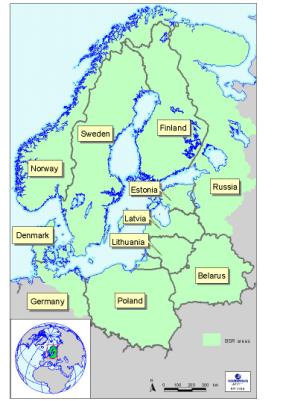VASAB 2010+ - Spatial Development Action Programme: Background documents
A follow-up project to VASAB 2010 (Vision and Strategies around the Baltic Sea 2010 - Towards a Framework for Spatial Development in the Baltic Sea Region)
|
Prepared by
Holger Platz
|

|
PLANCO Consulting GmbH, Essen
Lilienstr. 44, D-45133 Essen
Tel. +49-201-43771-0; Fax +49-201-411468
e-mail: planco@planco.de
http://www.planco.de
|
supported by an international consultant team and based
on intensive discussions with the Committee on Spatial Development of the Baltic
Sea Region.
For further information on contributors see the back pages.
This report is complementary to the main report ‘VASAB2010Plus
– Spatial Development Action Programme’. Both reports can also be found at the
VASAB home page: www.vasab.org.pl.
February 2001
FOREWORD
VASAB – Vision and Strategies around the
Baltic Sea 2010 - is a co-operation among ministers responsible for spatial
planning and development, of the countries around the Baltic Sea. Germany and
Russia participate also through representatives from the regions which are adjacent
to the Baltic Sea Region (Länder in Germany, Oblasts and Republics in
Russia).
In 1994, a report ‘VASAB2010 – Vision and
Strategies around the Baltic Sea 2010’ was presented, being the first transnational
vision for spatial development world-wide. It was adopted at a Ministerial Conference
in Tallinn (Dec-1994) and laid the foundation for joint action of the participating
countries and regions.
Partners
in the VASAB initiative

|
An updated action programme has
been prepared by the VASAB co-operation, laid down in a new report, VASAB2010
Plus - Spatial Development Action Programme' (January 2001) - in brief: VASAB2010Plus
report. This report reflects the experience made during several years of co-operation,
changed conditions after a first decade of transition, new knowledge on spatial
trends in the Baltic Sea Region, and results of a diversity of transnational
co-operation projects on spatial development.
Purpose of the background report:
The background report presents main results of corresponding analyses which
formed the basis for the Action Programme. In a first part, spatial trends
in the Baltic Sea Region are analysed with a view at identifying future challenges
for spatial policies. In the report VASAB2010Plus, these challenges are translated
into proposals for future transnational spatial development action. In a second
part, national documents on spatial policy matters are reviewed, to assess
the need to reinforce the transnational dimension in national spatial plans
and programmes. In a third part, actions of the VASAB co-operation are
evaluated, which were taken after adoption of the VASAB2010 Vision and Strategy
report (1994). The purpose of this analysis is to draw conclusions for future
ways of action. This analysis includes also projects initiated through the InterregIIC
programme, and puts them into the context of spatial policy priorities as identified
by the VASAB co-operation.
The Committee on Spatial Development
of the Baltic Sea Region, February 2001
Table of content
Abbreviations, acronyms, organisations of pan-Baltic importance
I. SPATIAL TRENDS AND
CHALLENGES
1. Socio-economic development trends in the nineties
1.1 Transition and transformation
1.2 Welfare
1.3 Demography
1.4 Changing trade links
1.5 Growing communication
intensity
1.6 System changes
2. Environmental trends
2.1 Environmental regulations
2.2 Environmental Quality
2.3 Nature
3. Spatial structures and trends
3.1 Settlement system
3.2 Mobility network
3.3 Nature areas
3.4 Cultural landscapes
3.5 Coastal areas
3.6 Islands
4. Spatial cohesion
4.1 Growing regional disparities
4.2 Regional impacts of structural
economic change
4.3 Unfavourable regional spatial
structures
4.4 Accessibility improvements
and deficits
II. TRANSNATIONALITY
IN NATIONAL SPATIAL policy documents OF BSR COUNTRIES
1. Settlement system
2. Infrastructure system
3. Green System
4. Planning System
5. Summary
III. PROMOTION OF
THE VASAB 2010 STRATEGY
1. Dissemination of VASAB concepts
2. Generation of project ideas
and support to applicants
3. VASAB projects and InterregIIC
projects on issues promoted by VASAB
3.1 Cross-border co-operation
for regional development
3.2 Urban system
3.3 Spatial development and
the transport system
3.4 Regional development in
rural areas
3.5 Sustainable development
of coastal zones
3.6 Planning tools and methods
3.7 Conclusions
4. Co-operation for spatial
development in the BSR of VASAB with other organisations
ANNEX 1: Abbreviations, Acronyms, Organisations
of pan-Baltic importance
ANNEX 2: Sources on national
spatial planning in BSR countries
ANNEX 3: Members of CSD-BSR
ANNEX 4: Consultants involved in preparation of this
report
| 
